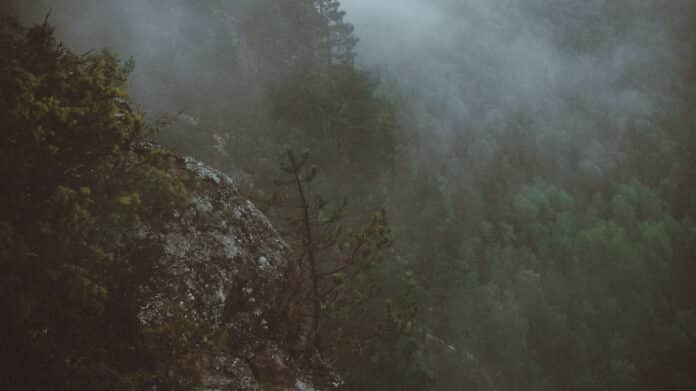You and I must save the PR industry.
PR is in constant flux, and our industry must evolve.
Yes, we recently missed our window.
But we can still fix ourselves — via online education.
Here we go:
The Digital Transformation of PR
PR Must Adapt — Or Die
Digital media will be the prime mover of people’s perceptions for a long time. It has become our number-one source for information, group formation, and dialogue.
The biggest challenge in modern public relations is the constantly changing media landscape. With the proliferation of social media, the rise of fake news, and the decline of traditional journalism, it can be difficult for organisations to control the spread of information and protect their reputations.
When Brian Solis and Deirdre Breakenridge published Putting the Public Back in Public Relations: How Social Media Is Reinventing the Aging Business of PR in 2009, it proposed how PR should embrace the digital-first media landscape and elevate our profession to new heights. 1Solis, B. & D. Breakenridge (2009, February 1). Putting the Public Back in Public Relations: How Social Media Is Reinventing the Aging Business of PR. Amazon.com: Books. … Continue reading
As we choose our future as public relations professionals, we must realise that the internet and its algorithms are more powerful than a few (barely surviving) newspapers.
The era of traditional print media is over:
Digital-first is no longer a matter of perspective — it’s a promise.
If we allow the world to think of PR professionals as outdated flacks, we’ll fade into oblivion while armies of digital marketers take over our responsibilities.
PR professionals must be strategic and proactive in their approach and able to adapt to new technologies and platforms to communicate effectively with their publics.
“The authors argue that earlier paradigms are mostly inadequate in addressing the needs of a 21st Century in which communication technology is creating rapid globalization while it is dangerously exacerbating the tensions of multiculturalism. Through a critical discussion of prior assumptions and paradigms in public relations scholarship, the authors underline the need for public relations to revitalize and bring its body of knowledge into the 21st Century.”
Source: Public Relations Review 2Valentini, C., Kruckeberg, D., & Starck, K. (2012). Public relations and community: A persistent covenant. Public Relations Review, 38(5), 873 – 879. https://doi.org/10.1016/j.pubrev.2012.06.001
The biggest challenge in PR is ensuring that our profession keeps up with new communication technology and stays valuable and relevant as a business function.
So, what does this mean?
It means that digital communication is not a fad.
It means that we must adapt — or perish.
Learn more: PR Must Adapt (Or Die)
We Had Our Window (But Missed It)
After the dot-com bubble in 2000 – 2001, the internet slowed down. Social media emerged with behemoths like Facebook, founded in 2004 and Twitter in 2006. Their social engineering aimed to connect people rather than turn them into online buying machines.
For a good number of years, internet monetisation progressed slowly. We got to experience the Hippie Web (2005 – 2015) revolving around earned and owned media. It was a golden opportunity for PR to gain traction in a space dominated by two-way communication, relationships, and trust circles. 3Silfwer, J. (2012, January 22). The Hippie Web is Dead (2005 – 2015). Doctor Spin | The PR Blog. https://doctorspin.net/hippie-web/
The window of earned-owned supremacy was never going to stay open forever. One and a half decades after the dot-com bubble, the Money Web (2015 – present) began to gain momentum. On the internet today, everything is marketing — except perhaps for Wikipedia and a few remaining journalists not hiding behind paywalls. 4Silfwer, J. (2012, September 8). Enter the Money Web (2016 – Present). Doctor Spin | The PR Blog. https://doctorspin.net/money-web/
We had a window. We missed it.
How Marketing Kicked Our PR Ass
Today, SEO (like SEM) is considered a form of marketing instead of earned and owned communication.
And the list goes on:
Make no mistake about it — this is a PR failure of epic proportions.
Doesn’t the PESO model make it clearer? 5Silfwer, J. (2012, April 13). The Peso Model: Paid, Earned Shared, and Earned Media. Doctor Spin | The PR Blog. https://doctorspin.net/peso-model/
Paid online media has its fair share of challenges, but a profound lack of PR knowledge is causing marketers real headaches. This is no mystery: online marketers mainly deal with earned and owned media. Still, they derive their way of thinking from marketing perspectives.
Sorry for being blunt: on the internet, the paid media mindset is just tactical icing on a strategic cake, a welcome boost when everything else is in working order.
As marketers, they know how to push products and services.
But they lack basic PR knowledge.
Marketers will protest. And then they will celebrate a 2% conversion rate without giving the other 98% a single thought.
And it gets worse.
The Generational Disconnect in PR
Organisations are left with impossible choices with many new digital industries and specialisations. What should an organisation do?
Having truckloads of agencies adds complexity and kills ROI. Hiring an army of in-house specialists causes bloat — and kills ROI.
The outcome? Marketing departments keep doing what they do best: pushing market campaigns to sell online and offline products and services. Everything else? Everything else is left in a big dirty pile on the communication department’s doorstep. And it’s a mess.
No wonder communication departments worldwide struggle with digital transformation issues: Fresh PR hires from school haven’t been taught the first thing inbound strategies, conversion tactics, or ranking factors. When communication departments look outside the organisation for specialists, they find … legions of marketers. It’s one big disconnect.
I constantly hear younger professionals disregard senior ones because “they don’t understand TikTok or Twitch.” Conversely, senior professionals disregard younger ones since “they don’t understand the fundamentals of corporate communication.”
We’re quickly losing knowledge and practical skills at both ends.
Save the PR Industry Now
The PR industry must save itself.
And there’s only one way forward — education.
However, traditional education is slow and time-consuming. The dynamics of the online media landscape will have changed many times before PR students get their hands on a relevant textbook. And we can’t expect senior professionals to quit their jobs and return to school for years.
PR does have a bright future still.
With many AI breakthroughs fast approaching, the internet will reward communicators who can leverage earned and owned channels to build online audiences. If we want to manifest change, the educational responsibility falls heavily on us all.
Digital PR specialists must share what they do, how they do it, and why. Even if that means sharing their best secrets for which they typically charge good money.
As for everyone in the PR industry, support the creators when great online PR courses start to pop up everywhere. Share their work. Invest in yourself.
Mark my words: it must begin now:

THANKS FOR READING.
Need PR help? Hire me here.

PR Resource: The PESO Model
The PESO Model
I often use the PESO model to underscore the critical differences between marketing (paid media) and public relations (earned, shared, and owned media).
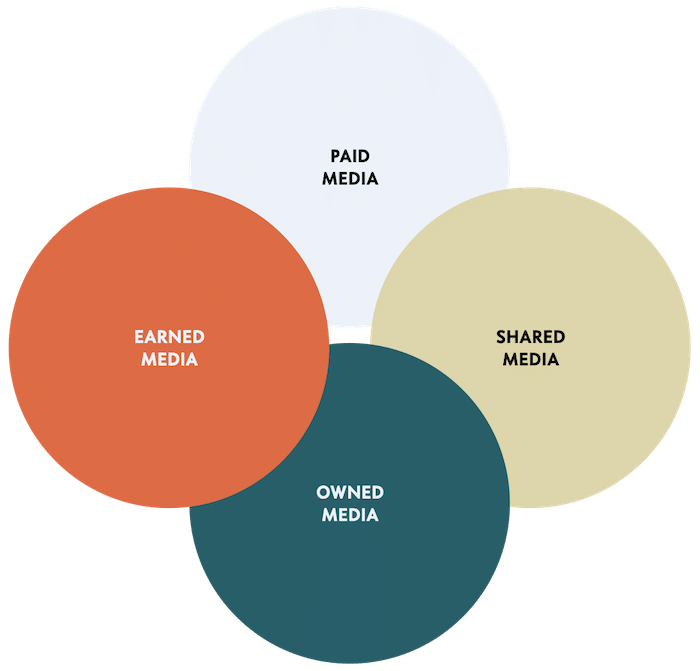
The PESO model divides the media landscape into four different media channel types:
Don Bartholomew, vice president of digital research at Fleishman Hillard, presented a version of the PESO model in 2010. According to PR blogger and PR measurement expert Heather Yaxley, his 2010 article is likely to be the earliest mention of the model:
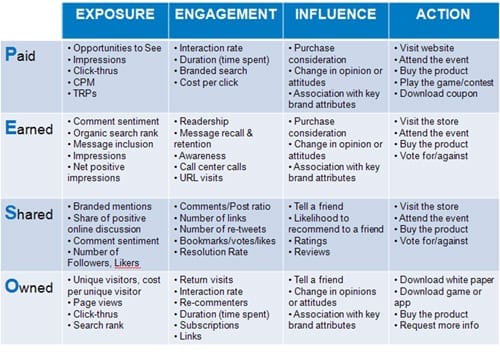
In 2013, PR blogger Gini Dietrich popularised the PESO model on her blog — and later trademarked! — her heavily promoted and widely spread infographic.
“In June 2013, Gini Dietrich presented the first iteration of the PESO model you may recognise in a blog post: The Four Different Types of Media. It was followed in August by the post Mobile Marketing: Use the Four Media Types in Promotion, where she talked about integrating paid, earned, owned, and shared.”
Source: PRConversations.com 6Yaxley, H. (2020, June 28). Tracing the measurement origins of PESO. PRConversations.com. https://www.prconversations.com/tracing-the-measurement-origins-of-peso/
“It is also worth pointing out this 2010 McKinsey Quarterly article by David Edelman and Britan Salsburg that includes sold and hijacked media alongside what used to be called POEM (paid, owned and earned media). Both of these concepts still have value even though their execution has changed in the past decade.“
Source: PRConversations.com 7Yaxley, H. (2020, June 28). Tracing the measurement origins of PESO. PRConversations.com. https://www.prconversations.com/tracing-the-measurement-origins-of-peso/
Learn more: The PESO Model: Paid, Earned, Shared, and Owned Media
PR Resource: The Electronic Age
Enter: The Electronic Age
Human culture is often described based on our access to production technologies (e.g., the Stone Age, the Bronze Age, and the Iron Age).
According to Marshall McLuhan and the Toronto School of Communication Theory, a better analysis would be to view societal development based on the prominence of emerging communications technologies.
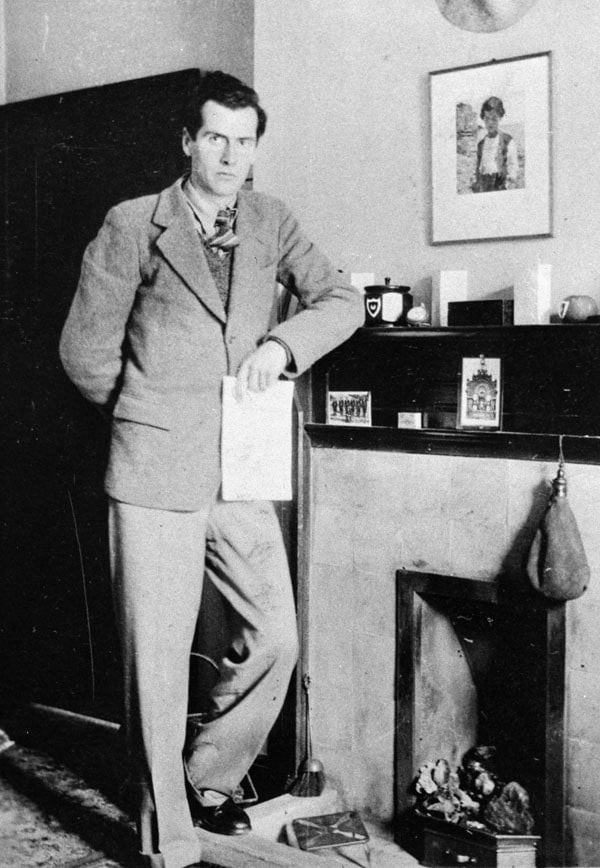
McLuhan’s Four Epochs
McLuhan suggests dividing human civilisation into four epochs:
“The Gutenberg Galaxy is a landmark book that introduced the concept of the global village and established Marshall McLuhan as the original ‘media guru’, with more than 200,000 copies in print.”
Source: Modern Language Review 8McLuhan, M. (1963). The Gutenberg galaxy: the making of typographic man. Modern Language Review, 58, 542. https://doi.org/10.2307/3719923
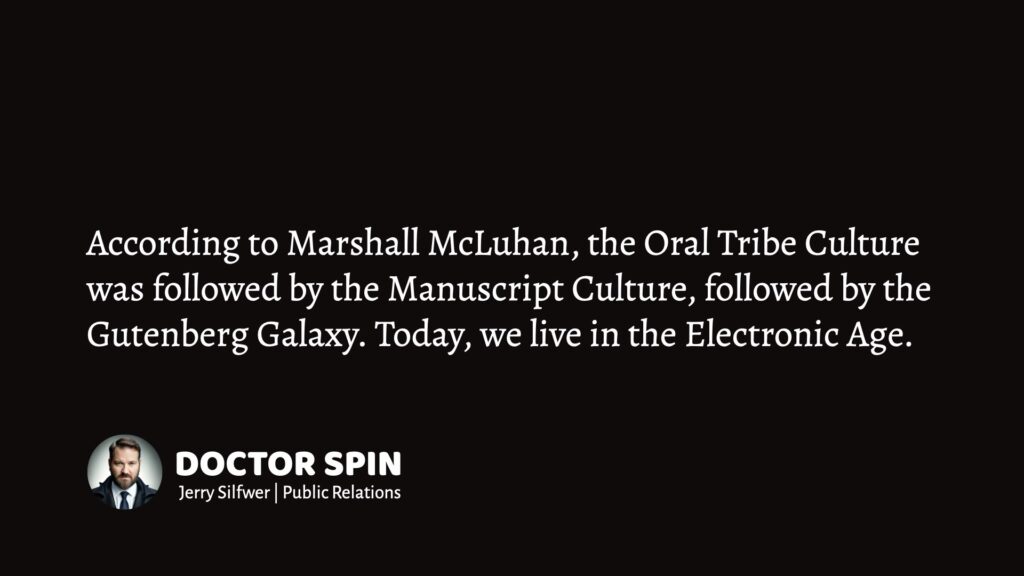
As a PR professional and linguist, I subscribe to the concept of the Electronic Age. I firmly believe society is unlikely to revert to the Gutenberg Galaxy.
Like the rest of society, the PR industry must commit to digital-first, too. Mark my words: It’s all-in or bust.
Read also: The Electronic Age and the End of the Gutenberg Galaxy
Annotations
| 1 | Solis, B. & D. Breakenridge (2009, February 1). Putting the Public Back in Public Relations: How Social Media Is Reinventing the Aging Business of PR. Amazon.com: Books. https://www.amazon.com/dp/0137150695?tag=pr200f-20&camp=14573&creative=327641&linkCode=as1&creativeASIN=0137150695&adid=02J76YW6R9GXVRCCJJM0& |
|---|---|
| 2 | Valentini, C., Kruckeberg, D., & Starck, K. (2012). Public relations and community: A persistent covenant. Public Relations Review, 38(5), 873 – 879. https://doi.org/10.1016/j.pubrev.2012.06.001 |
| 3 | Silfwer, J. (2012, January 22). The Hippie Web is Dead (2005 – 2015). Doctor Spin | The PR Blog. https://doctorspin.net/hippie-web/ |
| 4 | Silfwer, J. (2012, September 8). Enter the Money Web (2016 – Present). Doctor Spin | The PR Blog. https://doctorspin.net/money-web/ |
| 5 | Silfwer, J. (2012, April 13). The Peso Model: Paid, Earned Shared, and Earned Media. Doctor Spin | The PR Blog. https://doctorspin.net/peso-model/ |
| 6, 7 | Yaxley, H. (2020, June 28). Tracing the measurement origins of PESO. PRConversations.com. https://www.prconversations.com/tracing-the-measurement-origins-of-peso/ |
| 8 | McLuhan, M. (1963). The Gutenberg galaxy: the making of typographic man. Modern Language Review, 58, 542. https://doi.org/10.2307/3719923 |

